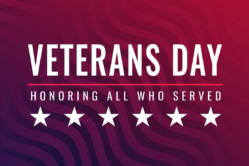Veteran’s Day is a holiday near and dear to the millions of Americans who have worn a military uniform or loved someone who has. Veterans Day serves as a way for Americans to honor and celebrate the sacrifice and bravery of the millions of men and women who have worn a military uniform in defense of our great nation. What follows is a brief history of Veteran’s Day.
The History of Veteran’s Day
Armistice Day – the original Veterans Day
Veteran’s Day hasn’t always been known as Veteran’s Day – it was originally known as Armistice Day in recognition of the armistice, or cease-fire, that ended the fighting during The Great War, which is now known as WWI. The armistice went into effect on the eleventh hour of the eleventh day of the eleventh month of 1918.
The Great War didn’t officially end until the Treaty of Versailles was signed on June 28, 1919, but President Wilson proclaimed November 11 as the first commemoration of Armistice Day because that marked the official end of hostilities in Western Europe.
President Wilson spoke the following words:
“To us in America, the reflections of Armistice Day will be filled with solemn pride in the heroism of those who died in the country’s service and with gratitude for the victory, both because of the thing from which it has freed us and because of the opportunity it has given America to show her sympathy with peace and justice in the councils of the nations…”
The original concept for the celebration was for a day observed with parades and public meetings and a brief suspension of business beginning at 11:00 a.m. Armistice Day was celebrated for the next few decades in remembrance of those who served in WWI.
Armistice Day becomes Veterans Day
In 1954, Armistice Day was officially changed to Veterans Day in order to recognize American veterans of all wars. This was less than a decade after the close of WWII, and right at the end of the Korean War.
Later that same year, on October 8th, President Dwight D. Eisenhower issued the first “Veterans Day Proclamation” which stated:
“In order to insure proper and widespread observance of this anniversary, all veterans, all veterans’ organizations, and the entire citizenry will wish to join hands in the common purpose. Toward this end, I am designating the Administrator of Veterans’ Affairs as Chairman of a Veterans Day National Committee, which shall include such other persons as the Chairman may select, and which will coordinate at the national level necessary planning for the observance. I am also requesting the heads of all departments and agencies of the Executive branch of the Government to assist the National Committee in every way possible.”
Veterans Day 1960s – 1970s
In 1968 Congress passed the Uniform Holidays Bill, which was designed to move several federal holidays to Mondays in order to create three-day weekends for federal employees. The goal was to encourage tourism and travel and give families more time together. The first holiday under the new law was celebrated on the last Monday in October in 1971. This caused a fair amount of confusion and many states elected to celebrate the holiday on its original date.
In 1975 President Gerald R. Ford recognized the historical significance of the original date and its importance to military veterans and signed a new law returning the observation of Veterans Day to November 11th beginning in 1978. If November 11 falls on a Saturday or Sunday, the federal government observes the holiday on the previous Friday or following Monday, respectively.
Veterans Day today
Veterans Day is more than a day on a calendar, more than a day off from work, and more than an excuse for a sale at the local furniture store. Today, as always, Veterans Day is a way to recognize all who have served in our nation’s military. To all who served – a simple thank you is never enough. But I’ll say it anyway. Thanks for your service.
Honoring Veterans: There are many people and companies who are proud to offer US Military Veterans a token of their appreciation. Here is a list of Veterans Day Events, Veteran’s Day Free Meals, and Veterans Day Discounts. Thanks to the many people and companies who work so hard to honor our country’s veterans.
President Eisenhower photo credit: VA.



Comments:
About the comments on this site:
These responses are not provided or commissioned by the bank advertiser. Responses have not been reviewed, approved or otherwise endorsed by the bank advertiser. It is not the bank advertiser’s responsibility to ensure all posts and/or questions are answered.
Anthony Joseph says
Veterans Day is a U.S. legal holiday dedicated to American veterans of all wars, and Veterans Day 2019 occurs on Monday, November 11. In 1918, on the 11th hour of the 11th day of the 11th month, an armistice, or temporary cessation of hostilities, was declared between the Allied nations and Germany in World War I, then known as “the Great War